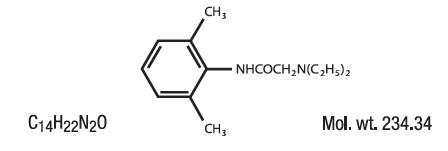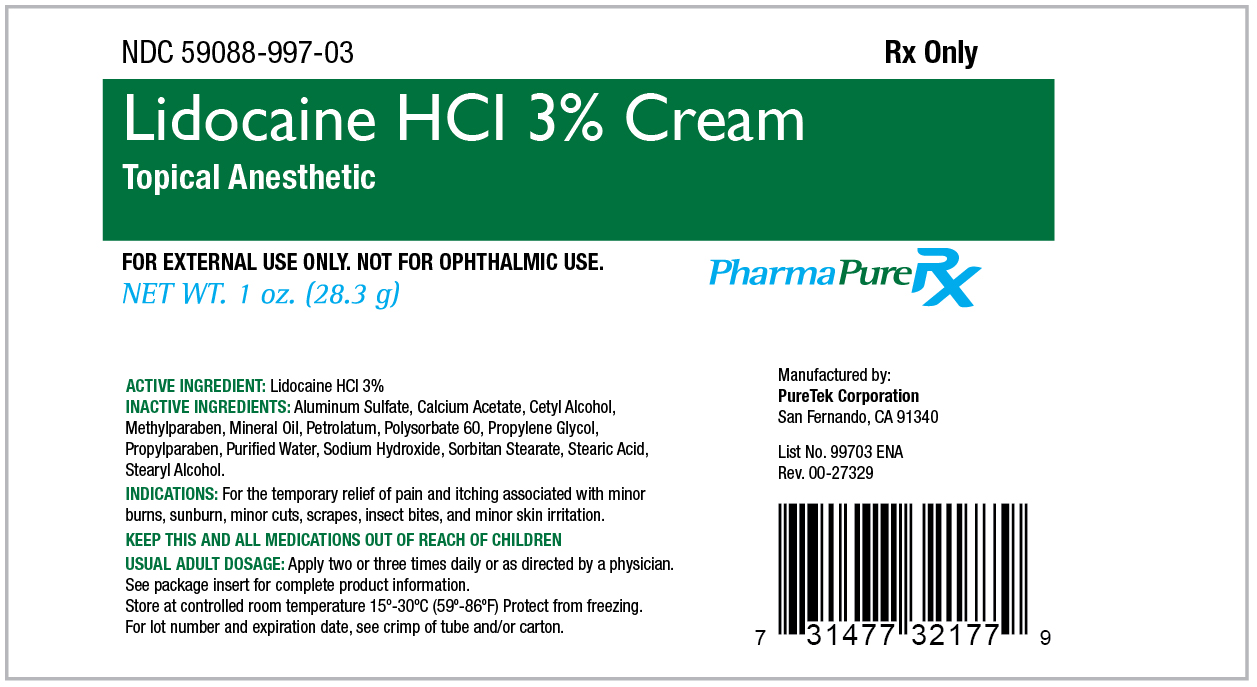Lidocaine Cream: Package Insert / Prescribing Info
Package insert / product label
Generic name: lidocaine hydrochloride
Dosage form: cream
Drug class: Topical anesthetics
Medically reviewed by Drugs.com. Last updated on Feb 4, 2025.
On This Page
Lidocaine Cream Description
Contains lidocaine HCl 3% in a mild acidic vehicle. Lidocaine is chemically designated as acetamide, 2-(diethylamino)-N-(2,6-dimethylphenyl).

INGREDIENTS:Each gram of PharmaPure Rx Lidocaine HCl 3% Creamcontains Lidocaine HCl USP 3%, Inactive ingredients include: Aluminum Sulfate, Calcium Acetate, Cetyl Alcohol, Methylparaben, Mineral Oil, Petrolatum, Polysorbate 60, Propylene Glycol, Propylparaben, Purified Water, Sodium Hydroxide, Sorbitan Stearate, Stearic Acid, Stearyl Alcohol.
Lidocaine Cream - Clinical Pharmacology
Enter section text here
MECHANISM OF ACTION
PharmaPure Rx Lidocaine HCl 3% Cream releases lidocaine from a mild acidic vehicle to stabilize the neuronal membrane by inhibiting the ionic fluxes required for initiation and conduction of impulses, thereby effecting local anesthetic action. A mild acidic vehicle lowers pH to increase protection against alkaline irritations and to provide a favorable environment for healing.
PHARMACOKINETICS
Lidocaine may be absorbed following topical administration to mucous membranes, its rate and extent of absorption depending upon the specific site of application, duration of exposure, concentration, and total dosage. In general, the rate of absorption of local anesthetic agents following topical application occurs most rapidly after intratracheal administration. Lidocaine is also well-absorbed from the gastrointestinal tract, but little intact drug appears in the circulation because of biotransformation of the liver.
Lidocaine is metabolized rapidly by the liver, and metabolites and unchanged drug are excreted by the kidneys. Biotransformation includes oxidative N-dealkylation, ring hydroxylation, cleavage of the amide linkage, and conjungation. N-dealkylation, a major pathway of biotransformation, yields the metabolites monoethylglycinexylidide and glycinexlidide. The pharmacological/toxicological actions of these metabolites are similar to, but less potent than, those of lidocaine. Approximately 90% of lidocaine administered is excreted in the form of various metabolites, and less than 10% is excreted unchanged. The primary metabolite in urine is a conjugate of 4-hydroxy-2, 6-dimethylaniline. The plasma binding of lidocaine is dependent on drug concentration, and the fraction bound decreases with increasing concentration. At concentration of 1 to 4 g of free base per mL, 60 to 80 percent of lidocaine is protein bound. Binding is also dependent on the plasma concentration of the alpha-1-acid-glycoprotein. Lidocaine crosses the blood-brain and placental barriers, presumably by passive diffusion. Studies of lidocaine metabolism following intravenous bolus injections have shown that the elimination half-life of this agent is typically 1.5 to 2 hours. Because of the rapid rate at which lidocaine is metabolized, any condition that affects liver function may alter lidocaine kinetics. The half-life may be prolonged two-fold or more in patients with liver dysfunction. Renal dysfunction does not affect lidocaine kinetics but may increase the accumulation of metabolites. Factors such as acidosis and the use of CNS stimulants and depressants affect the CNS levels of lidocaine required to produce overt systemic effects. Objective adverse manifestations become increasingly apparent with increasing venous plasma levels above 6 g free base per mL. In the rhesus monkey arterial blood levels of 18-21 g/mL have been shown to be threshold for convulsive activity.
Contraindications
Tuberculous or fungal lesions of skin vaccinia, varicella and acute herpes simplex and in persons who have shown hypersensitivity to any of its components. Lidocaine is contraindicated in patients with a known history of hypersensitivity to local anesthetics of the amide type.
Precautions
If irritation or sensitivity occurs or infection appears, discontinue use and institute appropriate therapy. Pharmapure Rx Lidocaine HCl 3% Creamshould be used with caution in ill, elderly, debilitated patients and children who may be more sensitive to the systemic effects of lidocaine.
CARCINOGENESIS, MUTAGENESIS, AND IMPAIRMENT OF FERTILITY
Studies of lidocaine in animals to evaluate the carcinogenic potential of the effect on fertility have not been conducted.
USE IN PREGNANCY
Teratogenic Effects:
Teratogenic Effects; Pregnancy Category B. Reproduction studies have been performed for lidocaine in rats at doses up to 6.6 times the human dose and have revealed no evidence of harm to the fetus caused by lidocaine. There are, however, no adequate and well-controlled studies in pregnant women. Animal reproduction studies are not always predictive of human response. General consideration should be given to this fact before administering lidocaine to women of childbearing potential, especially during early pregnancy when maximum organogenesis takes place.
NURSING MOTHERS:
It is not known whether this drug is excreted in human milk. Because many drugs are excreted in human milk, caution should be exercised when this drug is administered to a nursing mother.
PEDIATRIC USE:
Dosage in pediatric patients would be reduced commensurate with age, body weight and physical condition.
Adverse Reactions/Side Effects
During or immediately after treatment, the skin at the site of treatment may develop erythema or edema or may be the locus of abnormal sensation.
Related/similar drugs
Lidoderm
Lidoderm is a lidocaine patch used to relieve nerve pain after shingles by numbing the skin and ...
Lidocaine Viscous
Lidocaine Viscous is used for anesthesia, gastrointestinal surgery, gastrointestinal tract ...
Botox
Botox is used cosmetically to reduce facial lines and wrinkles and for medical purposes for ...
Westcort
Westcort is used for atopic dermatitis, dermatitis, eczema, intertrigo, pruritus, psoriasis ...
Anusol-HC
Anusol-HC is used for anal itching, hemorrhoids, proctitis, pruritus
Xylocaine Jelly
Xylocaine Jelly is used for anal itching, anesthesia, burns, external, gastrointestinal surgery ...
Benzocaine topical
Benzocaine topical is used for anal itching, anesthesia, aphthous ulcer, burns, external, cold ...
Phenylephrine topical
Phenylephrine topical is used for anal itching, hemorrhoids
Hydrocortisone topical
Hydrocortisone cream is used to treat eczema, dermatitis, psoriasis, hemorrhoids, insect bites or ...
Lidocaine Cream Dosage and Administration
Apply a thin film to the affected area two or three times daily or as directed by a physician.
How is Lidocaine Cream supplied
PharmaPure Rx Lidocaine HCl 3% Cream
1 oz (28.3g) tube - NDC 59088-997-03
3 oz (85 g) tube - NDC 59088-997-07
| LIDOCAINE HCL
lidocaine hcl cream |
||||||||||||||||||||||||||||||||
|
||||||||||||||||||||||||||||||||
|
||||||||||||||||||||||||||||||||
|
||||||||||||||||||||||||||||||||
|
||||||||||||||||||||||||||||||||
|
||||||||||||||||||||||||||||||||
| Labeler - PureTek Corporation (785961046) |
| Establishment | |||
| Name | Address | ID/FEI | Business Operations |
|---|---|---|---|
| PureTek Corporation | 785961046 | manufacture(59088-997) | |
More about lidocaine topical
- Check interactions
- Compare alternatives
- Pricing & coupons
- Reviews (248)
- Latest FDA alerts (8)
- Side effects
- Dosage information
- During pregnancy
- Drug class: topical anesthetics
- Breastfeeding
- En español
Patient resources
Professional resources
- Lidocaine (Topical) monograph
- Lidocaine Gel (FDA)
- Lidocaine Jelly (FDA)
- Lidocaine Lotion (FDA)
- Lidocaine Ointment (FDA)
Other brands
Lidocaine Viscous, Lidocan Patch, ZTlido, Xylocaine Jelly, ... +35 more

